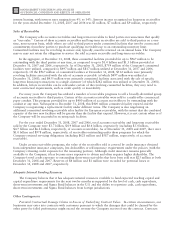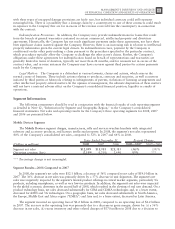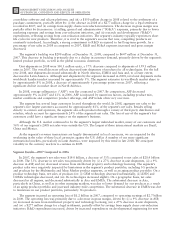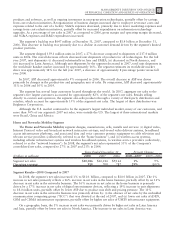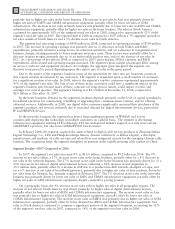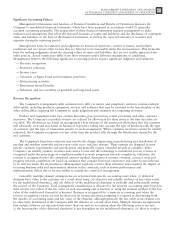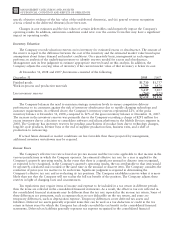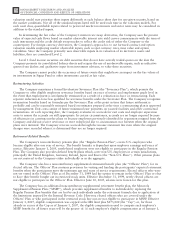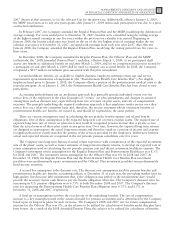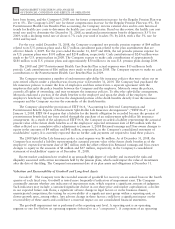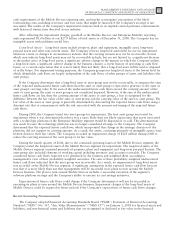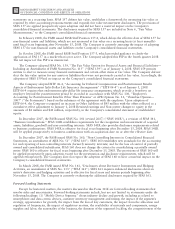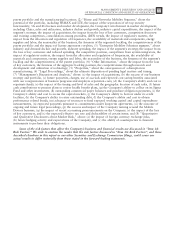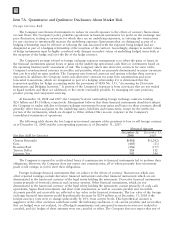Motorola 2008 Annual Report Download - page 77
Download and view the complete annual report
Please find page 77 of the 2008 Motorola annual report below. You can navigate through the pages in the report by either clicking on the pages listed below, or by using the keyword search tool below to find specific information within the annual report.
statements for which payment has been deferred or expense for which the Company has already taken a deduction
on an income tax return, but has not yet recognized in the consolidated financial statements.
The Company accounts for income taxes in accordance with Statement of Financial Accounting Standard
(SFAS) No. 109, “Accounting for Income Taxes,” which requires that deferred tax assets and liabilities be
recognized using enacted tax rates for the effect of the temporary differences between the book and tax basis of
recorded assets and liabilities. The Company makes estimates and judgments with regard to the calculation of
certain income tax assets and liabilities. SFAS No. 109 requires that deferred tax assets be reduced by valuation
allowances if, based on the consideration of all available evidence, it is more likely than not that some portion of
the deferred tax asset will not be realized. Significant weight is given to evidence that can be objectively verified.
The Company evaluates deferred income taxes on a quarterly basis to determine if valuation allowances are
required by considering available evidence, including historical and projected taxable income and tax planning
strategies that are both prudent and feasible. As of December 31, 2008, the Company’s U.S operations had
generated two consecutive years of pre-tax losses, which are attributable to the Mobile Devices segment. During
2007 and 2008, the Home and Networks Mobility and Enterprise Mobility Solution businesses (collectively
referred to as the “Broadband Mobility Solutions business”) were profitable in the U.S. and worldwide. Because of
the 2007 and 2008 losses at Mobile Devices and the near-term forecasts for the Mobile Devices business, the
Company believes that the weight of negative historic evidence precludes it from considering any forecasted
income from the Mobile Devices business in its analysis of the recoverability of deferred tax assets. However, based
on the sustained profits of the Broadband Mobility Solutions business, the Company believes that the weight of
positive historic evidence allows it to include forecasted income from that the Broadband Mobility Solutions
business in its analysis of the recoverability of its deferred tax assets. The Company also considered in its analysis
tax planning strategies that are prudent and can be reasonably implemented. Based on all available positive and
negative evidence, we concluded that a partial valuation allowance should be recorded against the net deferred tax
assets of our U.S operations. During fiscal 2008, we recorded a valuation allowance of $2.1 billion. The
establishment of the valuation allowance was a non-cash expense.
The Company has a total deferred tax asset valuation allowance of approximately $2.7 billion against net
deferred tax assets of approximately $6.2 billion as of December 31, 2008, compared to total deferred tax asset
valuation allowance of $515 million against net deferred tax assets of $4.8 billion as of December 31, 2007.
Management believes its assumptions about the future performance of the Broadband Mobility Solutions
business and the ability of the Company to generate sufficient future taxable income to realize the remaining
deferred tax assets are reasonable. If the Broadband Mobility Solutions business does not meet these future
forecasts or if the Company no longer deems certain tax planning strategies prudent or feasible due to changes in
circumstances not currently contemplated, additional valuation allowances may be required in future periods.
Valuation of Sigma Fund and Investment Portfolios
The Company and its wholly-owned subsidiaries invest a significant portion of their U.S. dollar-denominated
cash in a fund (the “Sigma Fund”) that is designed to provide investment returns similar to a money market fund.
Investments in Sigma Fund are carried at fair value. Investments not held in Sigma Fund generally consist of equity
and debt securities, which are classified as available-for-sale and are carried at fair value.
The Company adopted Financial Accounting Standards Board (“FASB”) Statement of Financial Accounting
Standard (“SFAS”) No. 157, “Fair Value Measurements” (“SFAS 157”) on January 1, 2008 for financial assets and
liabilities, and non-financial assets and liabilities that are recognized or disclosed at fair value in the financial
statements on a recurring basis. SFAS 157 defines fair value, establishes a framework for measuring fair value as
required by other accounting pronouncements and expands fair value measurement disclosures. The provisions of
SFAS 157 are applied prospectively upon adoption and did not have a material impact on the Company’s
consolidated financial statements. Based on the framework provided by SFAS 157, the evidence to support the fair
value is as follows.
Quoted market prices in active markets are available for investments in publicly traded common stock and
equivalents and, as such, these investments are classified within Level 1.
The securities classified as Level 2 are primarily those that are professionally managed within the Sigma Fund.
The valuation models are developed and maintained by third-party pricing services and use a number of standard
inputs to the valuation model, including benchmark yields, reported trades, broker/dealer quotes where the party is
standing ready and able to transact, issuer spreads, benchmark securities, bids, offers and other reference data. The
69
MANAGEMENT’S DISCUSSION AND ANALYSIS
OF FINANCIAL CONDITION AND RESULTS OF OPERATIONS



